
Asteroids is a space-themed multidirectional shooter arcade video game designed by Lyle Rains and Ed Logg released in November 1979 by Atari, Inc. The player controls a single spaceship in an asteroid field which is periodically traversed by flying saucers. The object of the game is to shoot and destroy the asteroids and saucers, while not colliding with either, or being hit by the saucers' counter-fire. The game becomes harder as the number of asteroids increases.

Missile Command is a 1980 shoot 'em up arcade video game developed and published by Atari, Inc. and licensed to Sega for Japanese and European releases. It was designed by Dave Theurer, who also designed Atari's vector graphics game Tempest from the same year. The game was released during the Cold War, and the player uses a trackball to defend six cities from intercontinental ballistic missiles by launching anti-ballistic missiles from three bases.

Centipede is a 1981 fixed shooter arcade game developed and published by Atari, Inc. Designed by Dona Bailey and Ed Logg, it was one of the most commercially successful games from the golden age of arcade video games and one of the first with a significant female player base. The primary objective is to shoot all the segments of a centipede that winds down the playing field. An arcade sequel, Millipede, followed in 1982.
1980 saw the release of a number of games with influential concepts, including Pac-Man, Battlezone, Crazy Climber, Mystery House, Missile Command, Phoenix, Rally-X, Space Panic, Stratovox, Zork, Adventure, and Olympic Decathlon. The year's highest-grossing video game was Namco's arcade game Pac-Man, while the best-selling home system was Nintendo's Game & Watch. The Atari VCS also grew in popularity with a port of Space Invaders and support from new third-party developer Activision.
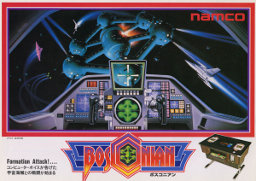
Bosconian is a multidirectional scrolling shooter arcade game which was developed and released by Namco in Japan in 1981. In North America, it was manufactured and distributed by Midway Games. The goal of the game is to earn as many points as possible by destroying enemy missiles and bases using a ship which shoots from both the front and back. Bosconian became the first shoot 'em up game to feature diagonal movement.

Liberator is an arcade game released by Atari, Inc. in 1982. It is based on the Atari Force comic book series published by DC Comics from 1982 to 1986. Liberator has been described as the opposite of Missile Command, in that the player destroys cities from space instead of defending them from the ground. Only 762 arcade machines were ever made.

Fatal Fury 3: Road to the Final Victory is a 1995 head-to-head fighting game released by SNK for the Neo-Geo arcade and home platforms. It is the fourth game in the Fatal Fury series after Fatal Fury Special. Console versions of Fatal Fury 3 were released for the Neo Geo CD, Sega Saturn, Windows-based computers and on the Wii Virtual Console. The game is also included in the compilation Fatal Fury Battle Archives Volume 1 for the PlayStation 2.

Atari: 80 Classic Games in One!, known as Atari Anthology on consoles, is a video game collection developed by Digital Eclipse and published by Atari Interactive. The title is a compilation of 80 video games previously published by Atari, Inc. and Atari Corporation, reproducing Atari's games from its arcade and Atari 2600 game console platforms. Many games permit one to play each title at varying speeds, with time limits, or with a shifting color palette.

Mattel Electronics Auto Race is the first in the line of many Mattel Electronics games, and it is credited with being the first handheld game that was entirely digital, with only solid-state electronics, having no moving mechanisms except the controls and on/off switch.
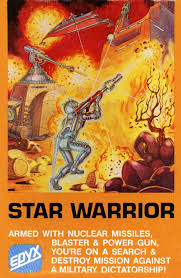
Star Warrior is a 1980 science fiction role-playing video game written and published by Automated Simulations for the Apple II, TRS-80, and Atari 8-bit family. The game is branded as part of the Starquest series, consisting of Star Warrior and the otherwise unrelated Rescue at Rigel.

Invasion Orion is a 1979 science fiction strategy game written and published by Automated Simulations. It is one or two player sequel to the original two-player Starfleet Orion which was published in late 1978. The game was written in BASIC for the Commodore PET and TRS-80 and ported to the Atari 8-bit family and Apple II.

Cytron Masters is a computer game by Dan Bunten released for the Apple II and Atari 8-bit family in July or August 1982. Developed by Ozark Softscape and released by Strategic Simulations, Cytron Masters is one of the earliest computer games that can be considered a real-time strategy game, or a real-time tactics predecessor to the genre, requiring the players to build up their forces in order to win.
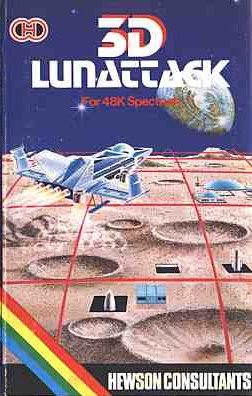
The Seiddab Trilogy is a series of video games designed by Steve Turner for the ZX Spectrum and published by Hewson Consultants. It consists of 3D Space-Wars (1983), 3D Seiddab Attack (1984), and 3D Lunattack. All three games were later published together as The Seiddab Trilogy by Hewson for the Rotronics Wafadrive. The series name is derived from the word "baddies" being spelt in reverse.
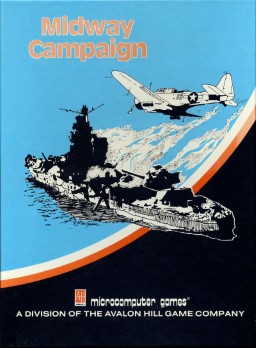
Midway Campaign is a strategy game developed by Avalon Hill in 1980. It is a wargame using ASCII text for the visuals and is written in BASIC.
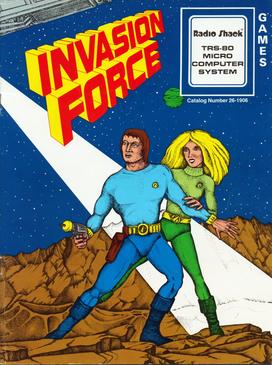
Invasion Force is a science fiction action video game produced by the Tandy Corporation in June, 1979. Invasion Force was a text-based, real-time, Star Trek style game.

Galaxy Invasion is a clone of Namco's Galaxian arcade game written by Big Five Software founders Bill Hogue and Jeff Konyu for the TRS-80 16K and published in 1980. It is the first game from Big Five to include sound and music. Galaxy Invasion was followed by an enhanced version in 1982, Galaxy Invasion Plus, which includes voice.

Super Nova is clone of Atari, Inc.'s Asteroids arcade game published by Big Five Software for the TRS-80 in 1980. Co-author Bill Hogue called Super Nova "the game that started the company."

ABM is a clone of Atari, Inc.'s Missile Command arcade game for the 32K Apple II. It was programmed by Silas Warner and published by Muse Software in 1980, the same year as Missile Command.

Missile Command 3D is a shoot 'em up video game developed by Virtuality Entertainment and published by Atari Corporation for the Atari Jaguar in North America on December 12, 1995, and Europe on December 15 of the same year. Part of Atari Corp.'s 2000 series, it is an update to Dave Theurer's 1980 arcade game Missile Command and the only officially released title that features support for the unreleased Jaguar VR peripheral.
Trek-80 is a text-based video game written by Steve Dompier in 1976 and sold by Processor Technology for their Sol-20 computer and suitable S-100 bus machines.

















